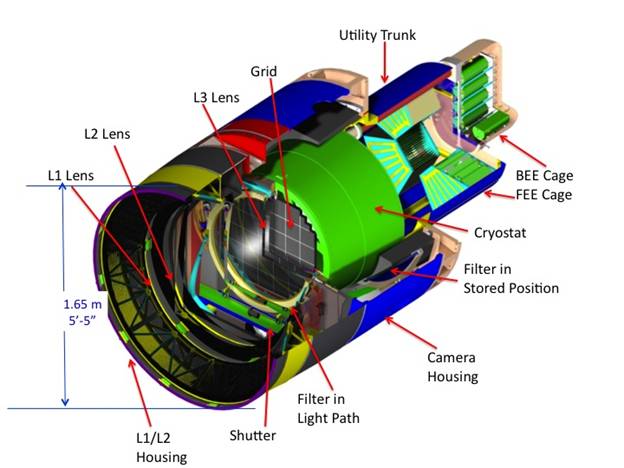The Large Synoptic Survey Telescope (LSST) is a large-aperture wide-field, ground-based telescope that will survey half the sky every few nights in six optical bands ranging from 320 to 1050 nm.
The LSST camera, currently in the final stages of the R&D phase ,will produce a data set that will allow us to better evaluate a wide range of pressing questions about the attributes of dark energy and dark matter, the formation of the Milky Way, the properties of small bodies in the solar system, the trajectories of potentially hazardous asteroids and the possible existence of undiscovered explosive phenomena.
The 8.4-meter LSST will be constructed on the El Penon peak of Cerro Pachon in northern Chile. Its three large telescope mirrors will be actively controlled to minimize distortions. The telescope mount will be a compact, still structure especially designed to reduce image motion. The LSST camera, which is made up of three refractive lenses and a 9.6-square degree field-of-view, will be the largest digital camera ever constructed. Once operational, the LSST will take a pair of 15-second exposures of each field thoughout the entire night. The camera’s 3.2-gigapixel focal plane array is comprised of 189 4Kx4K CCD sensors with 10 µm pixels. The sensors are deep depletion, back-illuminated devices with a highly segmented architecture that enables the entire array to be read out in 2 seconds.. The detectors are grouped into 3 x 3 arrays called "rafts." These rafts are identical and each contains its own dedicated front-end and back-end electronics boards, which fit within the footprint of its sensors, thus serving as a 144-megapixel camera on its own. The rafts and associated electronics are mounted on a silicon carbide (SiC) grid inside an Cryostat vacuum, with an intricate thermal control system that maintains the CCDs at an operating temperature of -100 ºC. The focal plane also contains four sets of guide sensors and wavefront sensors. Simulations demonstrate that the LSST can deliver a uniform and deep (24.5 mag in r-band for one 15s exposure)18,000 square degree survey and will produce over 5.2 million exposures in ten years. This “movie,” which is sensitive to redshifts of up to 3, will open an entirely new window on the universe: the time domain. LSST will produce on average 15 terabytes of data per night, yielding an uncompressed data set of 200 petabytes. Dedicated facilities will process the image data in near real time.
The development of the LSST Camera led by SLAC, involves a broad collaboration of institutions, including:
LSST Camera Institutions:
- SLAC National Accelerator Laboratory
- Brookhaven National Laboratory
- Lawerence Livermore National Laboratory
- Fermi National Laboratory
- Institut National de Physique Nucleaire and de Physique des Particules (IN2P3‐Collection of multiple labs)
University-based instrumentation groups:
- Harvard, U. of Pennsylvania, Purdue, Ohio State, U. of Illinois,
- UC Santa Cruz, U. of Arizona, UC Davis
You can learn more about the LSST camera at the LSST project webpage.
Click the images below to see a larger version

The entrance window to the Cryostat is the third of three refractive lenses. The other two lenses are mounted at the front of the Camera Body. The Camera Body also contains a mechanical shutter and a Filter Exchange system holding five large optical filters, any of which can be inserted into the Camera field of view for a given exposure. A sixth optical filter will also be fabricated; this filter can replace any of the five via a daytime procedure.

This simulated image is one LSST CCD (4kx4k) with 0.2” pixels, 0.4” see and a field of view ~13.7’x13.7’. This CCD is one of 189 full illuminated CCDs that comprise the LSST focal plane. The image includes all photons for a 15 second exposure emitted by stars and galaxies in the base catalog. The brightest start in the image are ~12 magnitude.







